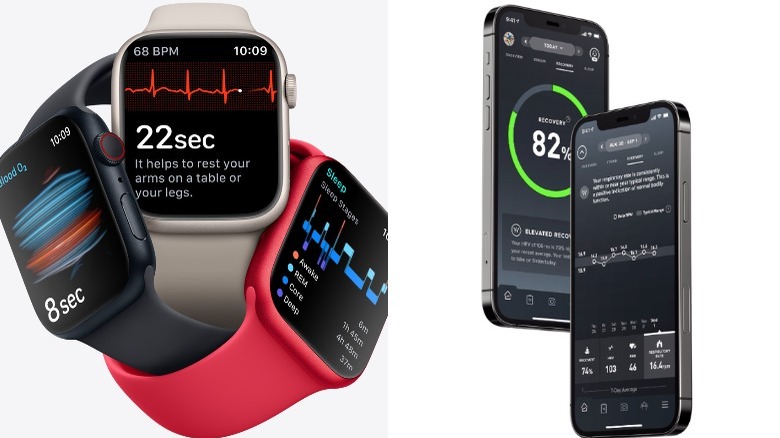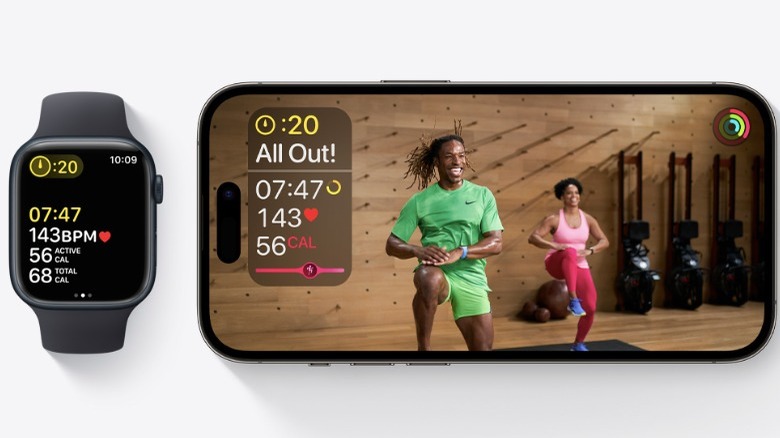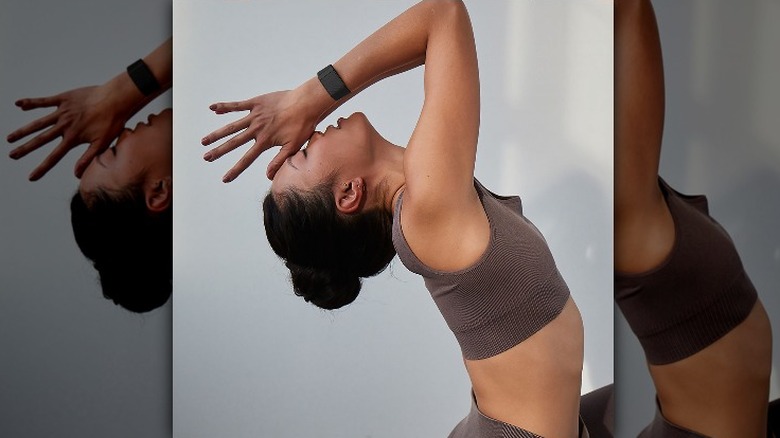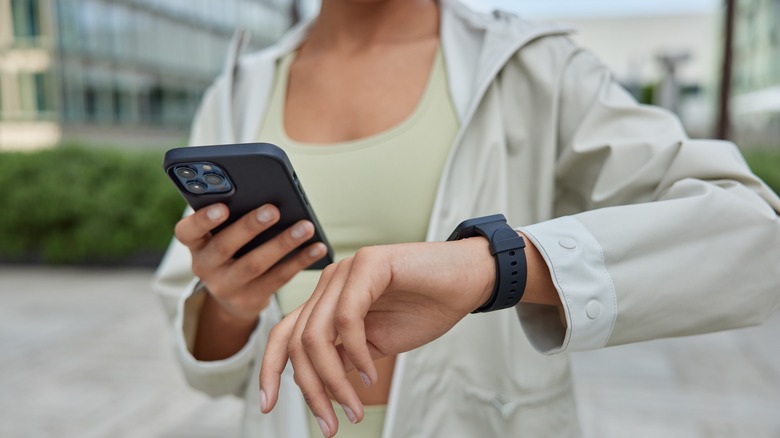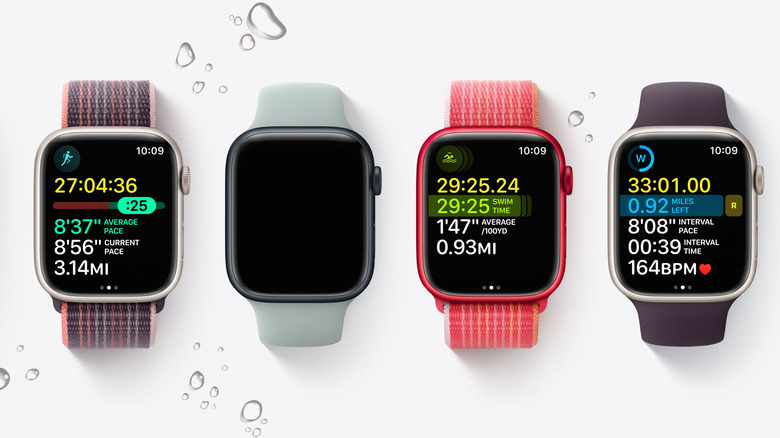Is The Apple Watch Or Whoop The Best Fitness Tracker?
We may receive a commission on purchases made from links.
Staying on top of keeping healthy and exercising can often be a difficult feat. On top of daily responsibilities, unexpected activities, and the lethargy that creeps in at the end of the day, fitting in a workout into all the chaos may be low on the list of things to do: despite it being an objective for 50% of Americans, according to a poll by YouGov America.
Even though it's a common goal, it continues to be a challenge for many people time and time again. Why? The Conversation believes that it's because people lack discipline and motivation when it comes to being persistent with their workouts. When they don't see instant results, their commitment falls off until they pick it back up much later.
While finding a fitness friend can increase your motivation to exercise, matching your schedule with another busy person isn't always feasible. So, why not let technology become your exercise partner? While the Apple Watch Series 8 is hailed as a great fitness tracker, the Whoop 4.0 may be a worthy contender.
A quick overview of both fitness trackers
Aside from answering calls and texts using Bluetooth and Wi-Fi, an Apple Watch has a myriad of fitness features, such as keeping track of your daily activities, measuring your heart rate and the calories you've burned, and multiple kinds of workouts. The Apple Watch also has competitions, awards, and personalized coaching so you can stay on course with your goals. The watch looks after your heart, alerting you about possible arrhythmias before you even notice them.
Using an app on your phone connected to the Whoop 4.0 fitness tracker, you can look at your activity levels, sleeping patterns, heart rate, and blood oxygen level. The watch offers you insight into your patterns and habits, sending advice via a notification so you can adjust your activity in order to optimize your health. Whoop looks at your recovery process, color coding stats to indicate how well you're coming along or whether you need to be doing something differently.
The Apple Watch ensures your workouts are effective
While both fitness watches attend to the health of the wearer, reports Wareable, the Apple Watch tracks the performance of the workouts you complete. Meanwhile, the Whoop focuses on the impact that your workouts have on you and what you can do to recoup.
According to Apple's website, the Apple Watch Series 8 has various-colored rings to help you visualize the progress you've made with goals such as exercises completed and how often you've moved throughout the day. With a $9.99 a month subscription to Apple Fitness+, you can access 11 various workouts, as well as guided walks and runs. However, you can also subscribe using just an iPhone (via The Verge). Even without the subscription, the watch has a lot of great features, Live Science mentions. It details the "zones" you're in at different workout stages, and you can also customize your workout using various modes.
The Series 8 also features temperature sensing with two sensors, one on the back crystal and another under the display. It notes decreases in body temperature, as well as increases, a phenomenon that happens when you're ovulating. You can also create sleep goals using your Apple Watch, setting different standards for the days of the week. Apple Support says the watch offers deeper information about your health via respiratory tracking while asleep. It informs you about the time you spent in each cycle, such as REM and deep sleep, to keep you aware of your patterns.
The Whoop 4.0 wants to help you recover
Targeted toward more serious athletes, the Whoop observes the state of your body after a workout (via Men's Journal). If the Apple Watch helps you set goals and stay on track, the Whoop is for the self-motivated athlete who knows how to work out, but needs help with what comes after.
The Whoop comes with dozens of workouts, from basketball and weightlifting to parkour and yard work. It sends information to your phone, gathering data on calories you've burned, sleep performance, how strenuous your workouts are, and what you can do to regain your strength.
Using a tracker is beneficial because it details your nervous system and lifestyle habits (per Harvard Health Publishing). The Whoop's data, in particular, is more advanced and accurate compared to many fitness trackers, reported Shape. It measures calories burned based on weight, height, and heart rate and recommends workout strengths determined by how well you slept. Like the Apple Watch, Whoop keeps tabs on how long you spent in various sleep cycles, monitoring how long you should sleep according to the activities of the day.
Wareable notes that the Whoop takes about two weeks to determine your range of respiratory rate, skin temperature, and blood oxygen level, alerting you to when you're experiencing changes, which can indicate illness. It also measures the mental and physical strain that is taxing your body from things like exercise, anxiety, and running errands.
Price, design, battery life, and tech compatibility
The Apple Watch Series 8 starts at $399. A Fitness+ subscription will run you $120 for one year. With a $30 a month for 12 months minimum subscription, you can get the Whoop and its benefits. You can also opt for a 24-month subscription that's $480 upfront or an annual membership that's $25 a month.
The crack, dust, and water-resistant Apple Watch has an Always-On display screen that is customizable. There are two case material options along with several case finish options. With style in mind, there are numerous band designs, ranging from leather to stainless steel, with the choice of a Nike logo.
Also waterproof, the Whoop 4.0 has a smaller, lightweight design. Although the Whoop bands have variety in color, they don't vary in material, with all of them being made with the same super knit fabric. The most prominent feature of the Whoop, however, is the lack of a screen. While it may be off-putting, it prevents distractions, with all reports being available on both the Android and iPhone apps.
Meanwhile, the Apple Watch only works with the iPhone, so it's not as accessible. Its battery life is also poor compared to other fitness trackers, with an 18-hour battery life (via Forbes). It takes a little over an hour for a full charge. Meanwhile, the Whoop has a five-day battery life, according to Dick's Sporting Goods. However, it takes about two hours to charge.
What's the best fitness tracker: Apple Watch or Whoop?
Depending on how serious your workouts are, it may be hard to determine which fitness tracker is the winner. However, if you're like most people, the Apple Watch Series 8 may be the best watch for your needs. The Chicago Tribune calls it an "effective fitness tracker" thanks to all its workout and health features. From basics such as steps taken and heart rate to its more advanced features like temperature and respiratory tracking, it's a health and lifestyle assistant for the everyday person.
The Whoop is an extremely advanced fitness tracker, used by many pro athletes (via CNBC). While it has a lot of detailed, high-tech features, unless being an athlete is your job or you take your health extremely seriously, the $30 every month payment may not be worth it. Its recovery-based data tracking is geared toward people who don't have trouble keeping up with workout goals or deciding what exercises they need to do. It analyzes the post-workout activities, letting you know the best way to rest so you can do it all over again.
The lack of a screen on the Whoop makes the Apple Watch a clear winner for general users. While it serves a function for seasoned exercisers, the notifications on the Apple Watch keep users up-to-date on the progress they're making. The Apple Watch is a lifestyle assistant made for daily wear, used to answer texts and calls and keep up with the weather.

